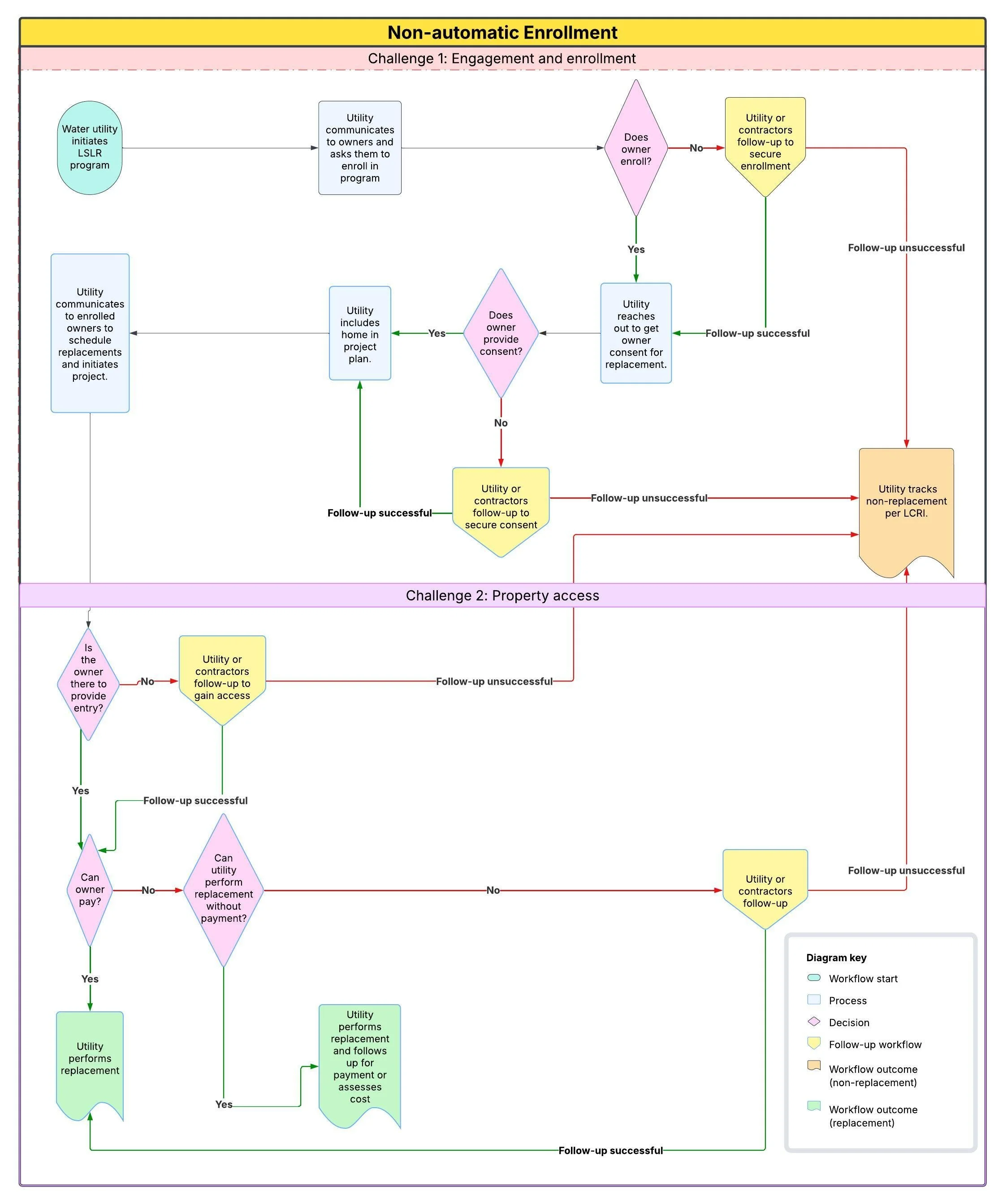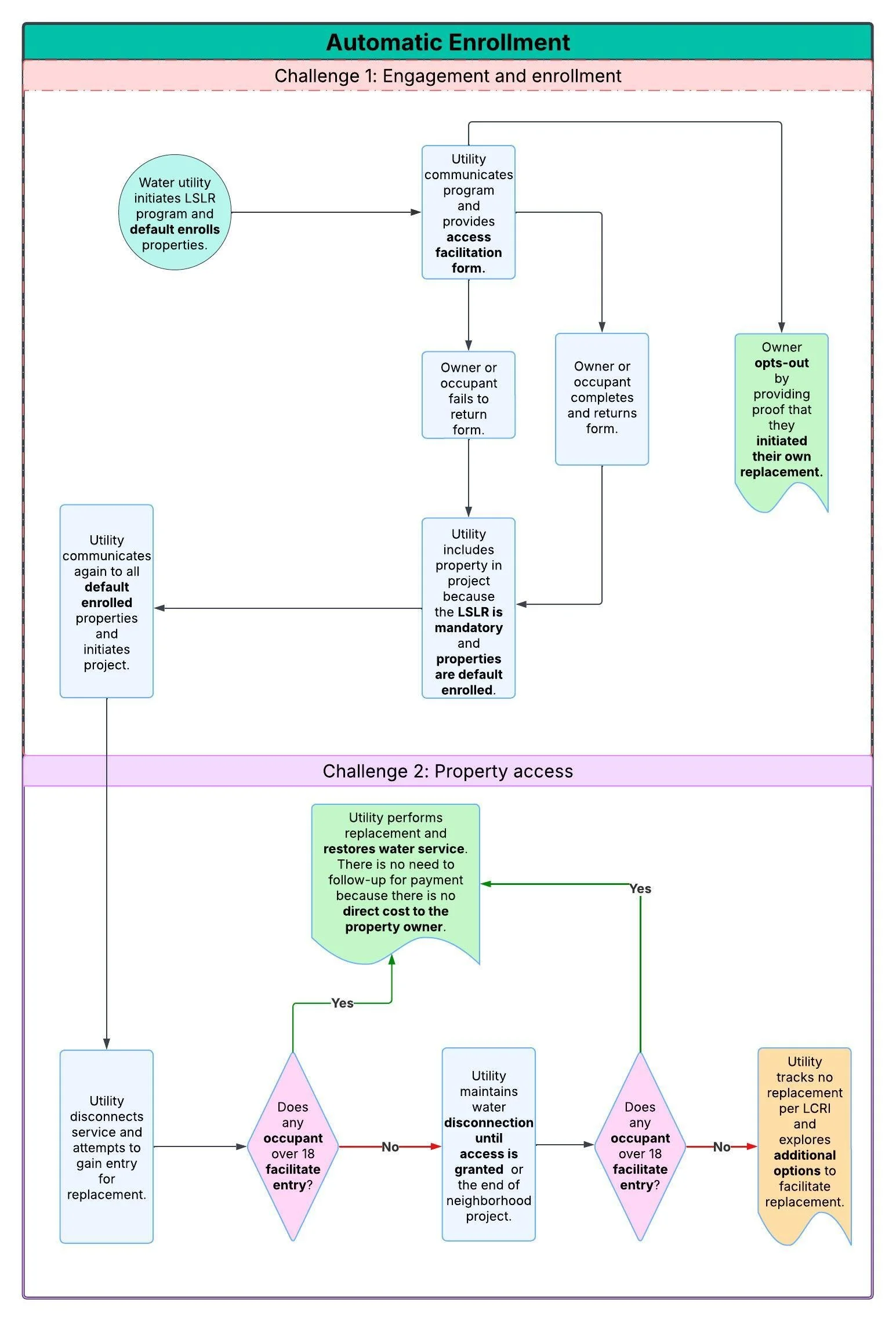Automatic Enrollment Policies Make Lead Service Line Replacement Projects More Efficient by Addressing Common Workflow Challenges
In our last automatic enrollment policy blog, we outlined automatic enrollment policies and highlighted how they can boost efficiency. In this follow-up, we outline common scenarios that water systems encounter when replacing lead service lines (LSLs) and how automatic enrollment policies help expedite replacements in each one. See our whitepaper on automatic enrollment policies and scenarios for a more detailed discussion of the content covered in both blogs, with additional analysis of the policies and how localities and states can implement them.
Automatic Enrollment Policies Review
To recap, automatic enrollment consists of six policies:
Mandatory lead service line replacement (LSLR)
No direct cost to property owners
Default enrollment
Opt-out through owner-initiated LSLR
Occupant facilitation of entry for LSLs
Water service restoration after LSLR
1. Mandatory LSLR
A lead service line replacement mandate is the foundation of automatic enrollment. Replacement can be achieved either through a water system project or through the property owner’s initiative.
2. No Direct Cost to Property Owners
Programs that replace LSLs at no direct cost to the property owner are better positioned to implement other automatic enrollment policies. By removing financial barriers, this policy increases participation and facilitates implementation of policies such as default enrollment and occupant-facilitated entry for LSLR, reducing the administrative burden of trying to identify owners and collecting payment information later.
3. Default Enrollment
Water systems that enroll properties by default and execute block-by-block projects without requiring owners to complete an enrollment form will reduce unnecessary and potentially confusing communications. Water systems should still seek information to facilitate access and secure entry for the LSLR before the start of the project by collecting what we refer to as an access facilitation form. Systems, however, should be able to proceed even without an access facilitation form, as outlined in the Scenarios section below.
4. Opt-Out Through Owner-Initiated Replacement
LSLR programs that require owners to prove they completed replacements within a set timeframe in order to opt out help avoid follow-up and scattered replacements later. This policy puts the onus on owners to demonstrate they should not be included in water system projects, allowing water systems to finalize project scopes more efficiently.
5. Occupant Facilitation of Entry for LSLRs
LSLR requires access to the water meter and entry to the property in the most common scenario, where the meter is located in the basement or anywhere else within the property. Water systems that can replace LSLs with occupant-allowed access will be able to execute block-by-block LSLR projects more quickly by cutting out time spent chasing recalcitrant landlords.
6. Water Service Restoration After Replacement
During any LSL project, water systems must temporarily disconnect water flow to the property while contractors replace any portion of the line (public or private sections). Reconnecting service only after the replacement can facilitate full LSLR and minimize the need for ongoing tracking of and outreach to properties with incomplete replacements.
Automatic Enrollment Scenarios
This section presents two different LSLR workflows—one that does not use any automatic enrollment policies and one that employs all the policies.
The non-automatic enrollment workflow often requires recourse to follow-up and results in project delays or properties falling out of block-by-block project plans altogether. Owners or occupants are required to enroll, sign, and return a right of entry form, and provide entry and access to the LSL in person. If owners or occupants fail to complete any of these steps, the water system must divert its energies to its follow-up processes and, if these fail, exclude the property from block-by-block project planning, resulting in LCRI-mandated follow-up. If the system requires owners to pay for a replacement, this adds an additional hurdle to participation and replacement. These engagement & enrollment and property access challenges often leave households out of block-by-block projects, require follow-up and more scattered replacements, and result in fewer replacements.
The automatic enrollment workflow emphasizes how automatic enrollment policies address these challenges, avoid unnecessary steps and follow-up, and facilitate replacements. Empowered by an LSLR mandate, the water system enrolls properties by default, and no direct payment is required to be included in the project. Since any occupant can facilitate access to the LSL, the system does not need to collect a right of entry form. Systems plan to include all households in their block-by-block projects. Once the project has been initiated, the system can replace LSLs even when the owner is absent, as long as an occupant facilitates entry. As part of the project, the water system will disconnect water service for all enrolled households, and can take advantage of the disconnection to engage households and obtain access to replace LSLs. The water system is able to replace more LSLs because automatic enrollment policies allow it to overcome engagement & enrollment and property access challenges to include more households in efficient block-by-block projects and dedicate its resources to replacements, not follow-up. Water systems can still benefit if they are only able to implement some of the automatic enrollment policies, as further explained in EPIC’s whitepaper on automatic enrollment policies.
The impact of an LSLR mandate coupled with default enrollment is illustrated by the workflow diagrams below. Without automatic enrollment, numerous follow-up steps (indicated by the yellow icons) may be required to engage owners or occupants who do not promptly and favorably respond to initial outreach efforts. Moreover, these steps might be repeated several times, depending upon how owners and occupants respond (indicated by the pink icons). With automatic enrollment, however, the ability of the planned project to proceed is not dependent on these follow-up steps or the desired owner or occupant response. Instead, owners and occupants are notified about the planned project and the mandatory LSLR policy under which the project is authorized and are automatically enrolled, unless the owner opts out by providing proof that they have initiated their own replacement. The water system will engage occupants to obtain entry, on the basis of the LSLR mandate and automatic enrollment, as the project proceeds.
Table Summarizing How Automatic Enrollment Policies Address Challenges
| Challenge | No direct cost | Mandatory LSLR | Default enrollment | Owner replacement to opt-out | Occupant facilitated entry | Service restoration after replacement |
|---|---|---|---|---|---|---|
| Engagement & enrollment | x | x | x | x | ||
| Property access | x | x | x | x |
Communication Is Key
To successfully deploy these policies to address these challenges and improve the owner and occupant experience, utilities will need to clearly communicate the policies. The prior diagrams simplify the engagement and communication portions of LSLR workflows, and it is important to emphasize in detail what effective outreach will communicate. This ensures that less outreach does not mean less engagement and instead reduces confusion. At a minimum, we assume LSLR program documentation will include the following:
Access facilitation forms that request:
Acknowledgment that a replacement is mandatory and that the utility and/or contractor is allowed to enter the dwelling when given access by any individual over the age of 18.
Acknowledgment that the occupant will need to arrange for someone over the age of 18 to be at the property to provide access once a replacement is scheduled.
Acknowledgment that, as part of the construction process for block-by-block LSLR programs, water service will be disconnected for a specific, limited time during the replacement, and that the interruption of service may extend beyond this time if the water system cannot access and replace the LSL.
Contact information to schedule the replacement once a project begins in the neighborhood.
Scheduling forms should advise owners and occupants that they can arrange for any individual to grant access to the contractor or utility at the scheduled time.
If the water system already has a scheduled project in the neighborhood when it reaches out, the form should request an acknowledgement of a specific time period for the replacement and allow for scheduling of the property’s replacement.
Payments or payment information if water systems need to collect a private-side cost-share. In this case, the form should make clear that the water system will not disconnect water because of unpaid cost-shares and highlight payment options. This will give owners and occupants confidence that they can participate even if they are unsure of their ability to pay.
The form or other documentation should clarify that the utility or contractor will make a reasonable effort to schedule access to the home within the construction period (e.g., 3-5 days), and, if unsuccessful, will need to discontinue water service until a time at which access can be granted.
Finally, the utility should provide notices on risk mitigation and other LCRI required information that help communicate the importance of LSLRs and engage occupants on steps to mitigate risks from LSLs and replacements. For example, program documentation should inform occupants that replacements can cause temporary increases in lead and that the system will provide filtration pitchers and six months of cartridges after replacement to mitigate this risk.
Conclusion
Many states and communities have demonstrated the feasibility of implementing automatic enrollment policies. These policies expedite replacements in common scenarios that water systems encounter in LSLR projects and address engagement & enrollment and property access challenges. Implementing these policies creates more efficient programs that avoid recourse to follow-up workflows. This makes LSLRs easier for owners and occupants and faster for utilities, spreading the joy of safe drinking water. If you missed the deep dive into automatic enrollment policies with examples from states and municipalities, see the previous blog—Automatic Enrollment Policies Can Make Lead Service Line Replacement Projects More Efficient and Expedient. And, for a comprehensive discussion of automatic enrollment policies and related scenarios, see our whitepaper.



